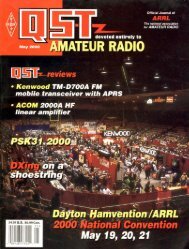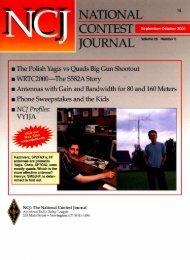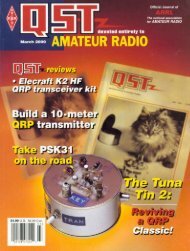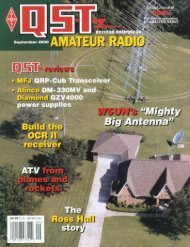Create successful ePaper yourself
Turn your PDF publications into a flip-book with our unique Google optimized e-Paper software.
CORRESPONDENCE<br />
Your opinions count! Send your letters to “Correspondence,” ARRL, 225 Main St, Newington, CT 06111.<br />
You can also submit letters by fax at 860-594-0259, or via e-mail to: qst@arrl.org.<br />
We read every letter received, but we can only publish a few each month. We reserve the right to edit your letter for clarity,<br />
and to fit the available page space. Of course, the publishers of <strong>QST</strong> assume no responsibility for statements made by correspondents.<br />
DTV: HYPE OR PROMISE<br />
Referring to the article by Peter Putman,<br />
KT2B, in the August <strong>QST</strong>, I trust he is enjoying<br />
his very expensive HDTV installation.<br />
As a retired TV engineer following 42<br />
years of broadcast activity, chief engineer<br />
of two TV stations and other radio stations<br />
and full responsibility from the camera lens<br />
to the beacon on the tip of the antenna, I’d<br />
like to offer my reactions to his comments.<br />
The transition from NTSC specs to<br />
HDTV specs is in no way similar to the transition<br />
from black/white TV to color TV. The<br />
B/W sets of the early TV days would still,<br />
with no modification, display B/W pictures<br />
from color broadcasts. A modern NTSC TV<br />
set will not display a DTV signal. Addition<br />
of a converter “box” will not change the<br />
sweep frequencies of the display. Even if the<br />
sync frequency of the broadcast signal is<br />
within the range of the set’s specs, the vertical<br />
resolution will not be improved. The horizontal<br />
resolution may be slightly better but<br />
very little due to the limited IF bandpass. The<br />
picture you will get after spending for the<br />
mandated converter “box” will give you<br />
about the same quality as you are accustomed<br />
to. The FCC has just made obsolete probably<br />
500 million TV sets. But, you say, the<br />
cable people will do the conversion for us.<br />
Yes, at great expense they will be forced to<br />
convert the DTV signals back to NTSC standards<br />
and probably the UHF signals back to<br />
their chosen channels. Does anyone believe<br />
they will do this for free<br />
The general public is not going to spend<br />
$3000, maybe $1000 at least, for a new TV<br />
set when their old one is operating perfectly.<br />
Reception on computers, with a<br />
receiver/converter depends on the sync frequencies<br />
of the broadcast signals, of which<br />
there are four different standards, at least<br />
two of which will not work.<br />
From the broadcaster’s standpoint, the<br />
FCC has mandated the complete junking of<br />
all the station equipment, cameras, microwave<br />
links, transmitters, antennas—the<br />
works. This will bankrupt many stations.<br />
NTSC can broadcast pictures that HDTV<br />
cannot. Visualize a screen full of random<br />
color pixels filling the 3.5-MHz bandwidth<br />
available for NTSC. Now randomly change<br />
the color of the pixels 30 times a second.<br />
NTSC can do that, compressed HDTV can’t.<br />
From an engineering standpoint HDTV<br />
is a stroke of genius. From a public acceptance<br />
standpoint it is going to be a long,<br />
hard climb. From a monetary standpoint it<br />
24 <strong>November</strong> <strong>2000</strong><br />
will be a flop. The FCC has just pronounced<br />
the death knell of open circuit TV. We will<br />
have to depend on satellite and cable services<br />
and deep pockets.—Rowland Medler,<br />
W4ANN, Gainesville, Florida<br />
CONTESTS DO NOT PREPARE<br />
OPERATORS FOR EMERGENCIES<br />
A letter from Dave Rosen, K2GM, published<br />
in the July, <strong>2000</strong> “Correspondence”<br />
addresses a belief that has been circulating<br />
within the Amateur Radio community for<br />
years. A segment of the Amateur Radio<br />
community has long suggested that contesters<br />
are “well prepared to deal with the operational<br />
demands that arise following disasters.”<br />
Perhaps the time has come to take<br />
a hard look at this belief and offer an alternative<br />
viewpoint.<br />
Unlike contesting, in which the information<br />
exchanged is often identical and<br />
repetitive, true disaster communications is<br />
often complex and lengthy. Few emergency<br />
communicators are afforded the luxury of<br />
transmitting the same message, consisting<br />
of just a few words, repeatedly throughout<br />
a period of extended operations.<br />
While it may be true that DXpeditions<br />
are logistical triumphs, they are nonetheless<br />
logistical triumphs that afforded the<br />
participants the luxury of months, or perhaps<br />
years, of preplanning. Disasters typically<br />
arrive with little, if any, notice.<br />
Furthermore, disasters often require the<br />
emergency communicator to deploy to a<br />
completely unfamiliar location, such as a<br />
hospital, shelter or Incident Command Post.<br />
Unlike most contesters, few emergency<br />
communicators have the luxury of providing<br />
disaster communications from home.<br />
There is no doubt that contesting is an<br />
honorable activity that offers many significant<br />
benefits. However, if one wishes to be<br />
fully prepared to provide emergency communications,<br />
there are activities that offer<br />
specific training for disaster response, including<br />
the League’s own ARES and NTS<br />
programs.<br />
For example, participating in ARES<br />
drills and exercises requires one to set up<br />
portable equipment at command posts,<br />
Emergency Operations Centers, hospitals or<br />
shelters. Such equipment may utilize technologies<br />
uncommon in contesting, such as<br />
APRS, or even ATV. ARES drills require<br />
one to transmit unfamiliar data and tactical<br />
information, such as chemical names, telephone<br />
numbers, addresses, or requests for<br />
supplies and personnel.<br />
Consider NTS nets. The dedicated<br />
traffic handler must meet on schedule, regardless<br />
of conditions. He must receive<br />
unfamiliar messages, many of which contain<br />
unique addresses, texts and signatures,<br />
regardless of propagation conditions or interference.<br />
He must be thoroughly familiar<br />
with a standard phonetic alphabet, the<br />
proper usage of prowords and prosigns, and<br />
the mechanics of net procedures.<br />
Whether intended or not, when one suggests<br />
that contesters are best qualified to<br />
support disaster communications, an implication<br />
is made that participation in ARES<br />
and NTS activities is unnecessary. Let’s<br />
encourage every contester to take time to<br />
register with his ARRL Emergency Coordinator<br />
or his NTS Net Manager instead.—<br />
Jim Wades, WB8SIW, Ypsilanti, Michigan<br />
EVERYTHING DOESN’T WORK<br />
“Everything Works” by Thomas Schiller,<br />
N6BT, in the July <strong>QST</strong>, told an interesting<br />
tale, but it might mislead new hams. It describes<br />
breaking DX pileups using only a<br />
light bulb for an antenna, it being only<br />
18-dB less effective than a dipole. (If the<br />
feed line truly doesn’t radiate, expect about<br />
–100 dB, and not hearing anything at all.)<br />
Figure 2 in the article positions triband trap<br />
Yagis as, on the average, no better performers<br />
than dipoles while according to everyone<br />
else, they are 5 to 8 dB better, not to<br />
mention being multiband. And while the<br />
“enjoyment” axis of the figure suggests the<br />
ultimate is using six of the author’s Force<br />
12 antennas, many hams expand their<br />
pleasure by trying different bands with trap<br />
antennas, exploring the MUF, adding amplifiers,<br />
trying VHF, exploring low-power<br />
portable operation, and by building. Nonetheless,<br />
most of us can relate to the article’s<br />
“path” discussion, and the role of the other<br />
ham’s station, topics that seem to come up<br />
early in a QSO.—Gary Gordon, K6KV,<br />
Saratoga, California<br />
Judging by the article “Everything<br />
Works” in the July, <strong>2000</strong> issue, <strong>QST</strong> has<br />
decided to get into the “irritainment” business.<br />
What bothers me is the idea that your<br />
enjoyment of Amateur Radio is in proportion<br />
to the effectiveness of your antenna.<br />
The article implies that you can’t really<br />
have much fun with anything less than a full<br />
sized dipole in the clear, higher than onethird<br />
wavelength, and even then, you are just<br />
“beginning to experience the fun of radio.”

















